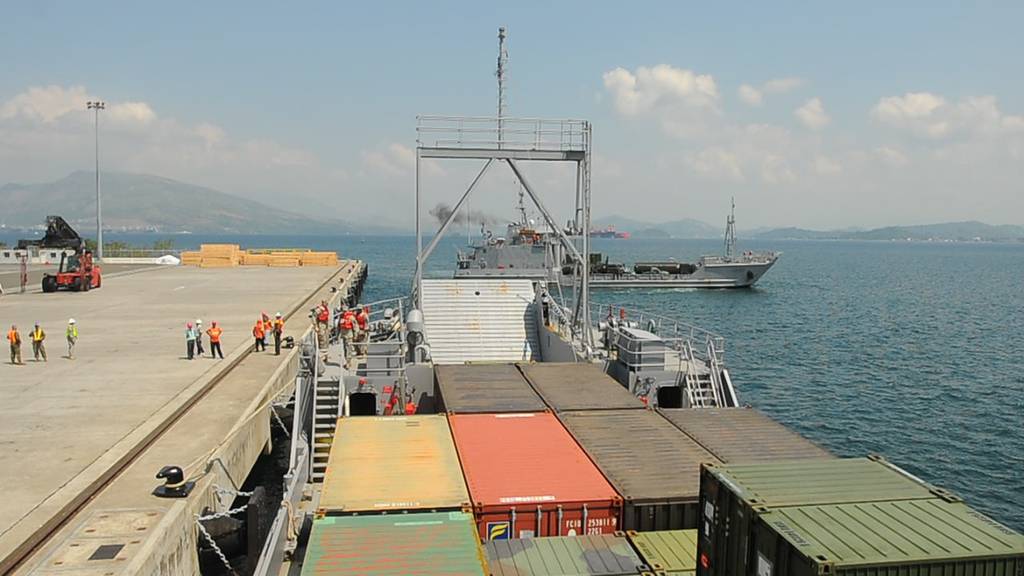beijingwalker
ELITE MEMBER

- Joined
- Nov 4, 2011
- Messages
- 65,191
- Reaction score
- -55
- Country
- Location
From Rockets to Ball Bearings, Pentagon Struggles to Feed War Machine
The flow of arms to Ukraine has exposed a worrisome lack of production capacity in the United States that has its roots in the end of the Cold War.
An Air Force technology expo in Aurora, Colo., this month. Major contractors like Lockheed Martin are looking across the United States to bring on new suppliers for missile programs.Credit...Rachel Woolf for The New York Times
By Eric Lipton
March 24, 2023
WASHINGTON — The Navy admiral had a blunt message for the military contractors building precision-guided missiles for his warships, submarines and planes at a moment when the United States is dispatching arms to Ukraine and preparing for the possibility of conflict with China.
“Look at me. I am not forgiving the fact you’re not delivering the ordnance we need. OK?” Adm. Daryl Caudle, who is in charge of delivering weapons to most of the Navy’s East Coast-based fleet, warned contractors during an industry gathering in January. “We’re talking about war-fighting, national security, and going against a competitor here and a potential adversary that is like nothing we’ve ever seen. And we can’t dillydally around with these deliveries.”
His open frustration reflects a problem that has become worryingly apparent as the Pentagon dispatches its own stocks of weapons to help Ukraine hold off Russia and Washington warily watches for signs that China might provoke a new conflict by invading Taiwan: The United States lacks the capacity to produce the arms that the nation and its allies need at a time of heightened superpower tensions.
Industry consolidation, depleted manufacturing lines and supply chain issues have combined to constrain the production of basic ammunition like artillery shells while also prompting concern about building adequate reserves of more sophisticated weapons including missiles, air defense systems and counter-artillery radar.
The Pentagon, the White House, Congress and military contractors are all taking steps to address the issues.
Procurement budgets are growing. The military is offering suppliers multiyear contracts to encourage companies to invest more in their manufacturing capacity and is dispatching teams to help solve supply bottlenecks. More generally, the Pentagon is abandoning some of the cost-cutting changes embraced after the end of the Cold War, including corporate-style just-in-time delivery systems and a drive to shrink the industry.
“We are buying to the limits of the industrial base even as we are expanding those limits,” Deputy Defense Secretary Kathleen Hicks said this month at a briefing on the Biden administration’s 2024 budget plan.
But those changes are likely to take time to have an effect, leaving the military watching its stocks of some key weapons dwindle.
Industry consolidation, depleted manufacturing lines and supply chain issues have combined to constrain the production of basic ammunition like artillery shells.Credit...Natalie Keyssar for The New York Times
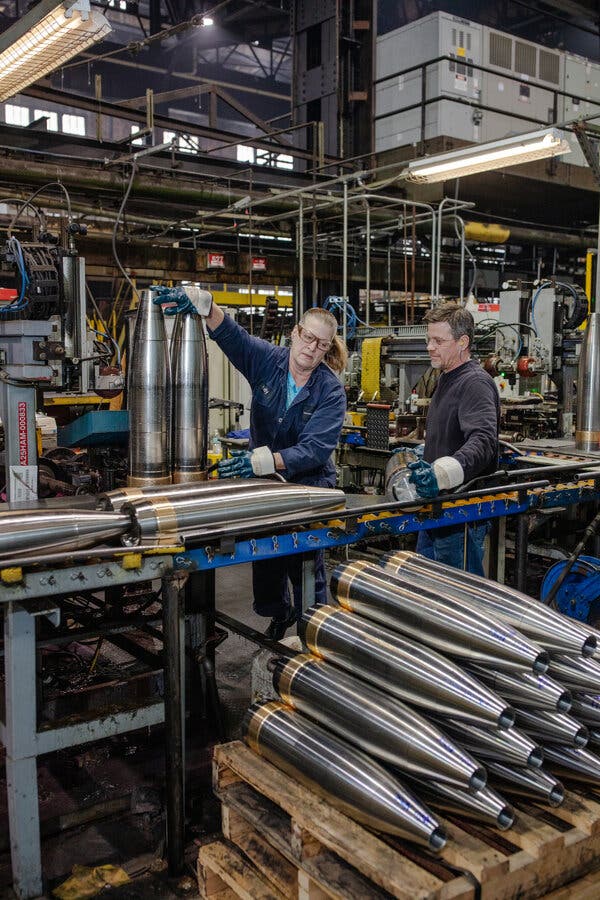
In the first 10 months after Russia invaded Ukraine, prompting Washington to approve $33 billion in military aid so far, the United States sent Ukraine so many Stinger missiles from its own stocks that it would take 13 years’ worth of production at recent capacity levels to replace them. It has sent so many Javelin missiles that it would take five years at last year’s rates to replace them, according to Raytheon, the company that helps make the missile systems.
If a large-scale war broke out with China, within about one week the United States would run out of so-called long-range anti-ship missiles, a vital weapon in any engagement with China, according to a series of war-game exercises conducted by the Center for Strategic and International Studies, a Washington-based think tank.
The shortcomings in the nation’s defense industrial base are vividly illustrated by the shortage of solid rocket motors needed to power a broad range of precision missile systems, like the ship-launched SM-6 missiles made by Raytheon.
It was the shortage of SM-6 missiles in particular that had Admiral Caudle fuming; they are used to defend ships against enemy aircraft, unmanned aerial vehicles and cruise missiles.
There are only two contractors today that build large numbers of rocket motors for missile systems used by the Air Force, the Navy, the Army and the Marines, down from six in 1995.
A recent fire disrupted the assembly line at one of the two remaining suppliers, Aerojet Rocketdyne, causing further delays in delivering the SM-6 and other precision missile systems, even as Pentagon orders for thousands of new missiles pile up.
Understand Biden’s Budget Proposal
President Biden proposed a $6.8 trillion budget that sought to increase spending on the military and social programs while also reducing future budget deficits.
- Recapturing a Centrist Identity: Biden has made curbing the budget gap one of his centerpiece promises. The move is part of a wider shift that sees the president speaking more to the concerns of the political middle.
- Reducing Deficit: Instead of talking about hard choices and freezing spending, the president has pledged to defend popular federal programs and rely on taxing corporations and high earners. That represents a break with the past.
- A Missing Plan for Social Security: Like the president’s previous budgets, his new proposal makes no mention of the program, which he promised to shore up during his 2020 campaign.
Aerojet is building motors for older systems such as Javelin anti-armor missiles and Stinger antiaircraft missiles, of which over 10,000 have already been sent to Ukraine. It is also building new rockets needed to power so-called hypersonic missiles that can travel much faster, as well as the rockets for a new generation of nuclear weapons for the United States and even the rocket for a new NASA spaceship soon headed to the moon.
The result is billions of dollars in backlogged orders at the company — and frustration at the Pentagon about the pace of delivery.
“At the end of the day, I want the magazines filled,” Admiral Caudle told contractors and Navy personnel in January, referring to the storage areas on his ships for guided missiles. “OK? I want the ships’ tubes filled.”
ADVERTISEMENT
“We’re talking about war-fighting, national security, and going against a competitor here and a potential adversary that is like nothing we’ve ever seen,” Adm. Daryl Caudle said. “And we can’t dilly dally around with these deliveries.”Credit...Alexi Rosenfeld/Getty Images

Other shortages slowing production include simple items such as ball bearings, a key component of certain missile guidance systems, and steel castings, used in making engines.
There is also only one company, Williams International, that builds turbofan engines for most cruise missiles, according to Seth G. Jones, a former Defense Department official now at the Center for Strategic and International Studies, weapons that would be vital for any war with China given their long range.
The current problems have their roots in the aftermath of the Cold War’s end, when a drive for the “peace dividend” led to cuts in weapons procurement and consolidation of the industry.
In 1993, Norman Augustine, then the chief executive of Martin Marietta, one of the largest of the military contractors, received an invitation to a dinner with Defense Secretary Les Aspin, who was helping President Bill Clinton figure out how to shrink military spending.
When he arrived, more than a dozen other chief executives from major contractors were there for a gathering that would become known as “The Last Supper.” The message delivered to the industry by Mr. Aspin was that many of the companies needed to disappear, by merging or going out of business.
“The cost would be enormous of maintaining the half-full factories, factory assembly lines,” Mr. Augustine, now 87, said in an interview at a coffee shop near his Maryland home, recalling the message shared with the executives. “The government was not going to tell us who the survivors would be — we were going to have to figure that out.”
Mr. Augustine still has a copy of a detailed “Last Supper” chart broken down by weapons systems that he typed up after the dinner. The total number of shipyards and tactical missile makers would each be cut to four from eight, while the number of rocket-motor manufacturers would be reduced to two from five.
Soon enough, Martin Marietta acquired GE Aerospace and General Dynamics’ Space Systems, and then merged with California-based Lockheed Corporation to form what is now known as Lockheed Martin.
“The conclusion they made — to get rid of most of the headquarters and the C.E.O.s and get the people left in the business operating at 100 percent, I think that was the right conclusion at the time,” Mr. Augustine said. “But it had long-term consequences. The challenge we face today was one of our own creation.”
Since the end of the Cold War, the United States — from the perspective of demands on its industrial base — has faced either short, high-intensity fights, like the first Persian Gulf war in 1990-91 and periods of the Iraq war starting in 2003, or prolonged but lower-intensity conflicts like the decades-long war in Afghanistan, said Michael E. O’Hanlon, a Brookings Institution military scholar.
But even these engagements, far different in scale from potential confrontations with other major powers, exposed the emerging risks: By 2016, the United States ran short of precision missiles after a series of fights in Afghanistan then Iraq, Libya and finally Syria.
The Pentagon briefly ramped up production to rebuild missile supplies, but it was a temporary move, said William A. LaPlante, the under secretary of defense who oversees acquisition. Defense Department leaders, and lawmakers who set the budget, would often turn to missile programs to cut spending totals.
An American volunteer teaching Ukrainian soldiers how to use a Javelin missile last year.Credit...Lynsey Addario for The New York Times

Prodded by military industry lobbyists — and the hundreds of retired high-ranking military officers they have hired to their sales and marketing teams — the government has instead mostly focused on buying new ships, planes and other extremely high-priced pieces of equipment, where the major contractors make most of their money.
Lobbyists have also pushed Congress to hold on to older ships and planes that even the Defense Department says have limited military value but which burn large amounts of money to equip and staff.
But the lower-priced items — like the missiles and other munitions — became an easy way to cut budgets to keep up spending on the big-ticket items.
“It becomes very attractive when our budgets are being balanced, to balance them on the munitions funds, because it’s fungible money,” Mr. LaPlante said. “We really allowed production lines to go cold and watched as parts became obsolete.”
That habit has also extended to European allies such as Poland, which has committed to buying F-35 fighter jets, which cost about $80 million apiece, but not enough missiles to use them for more than about two weeks in a war, said Mr. Hayes, the chief executive of Raytheon, whose Pratt & Whitney division builds engines for the fighter.
“We spend a lot of money on some very exquisite large systems, and we do not spend or focus as much on the munitions necessary to support those,” Mr. Hayes said in December. “Nobody’s buying the weapons systems necessary to engage for anything other than a very, very short-term battle.”
The Pentagon is now working to jettison an approach built around a Walmart-style just-in-time philosophy of keeping inventory low and instead focusing more on production capacity, Mr. LaPlante said in an interview.
The Biden White House this month proposed a 51 percent increase in the budget to buy missiles and munitions compared with 2022, reaching a total of $30.6 billion.
And that is just the start. The White House’s proposed budget just for Air Force missile procurement is set to jump to nearly $13 billion by 2028 from $2.2 billion in 2021. (Congress is just beginning to consider the administration’s proposals and those from both parties on Capitol Hill.)
Major contractors like Lockheed Martin, with the support of the Pentagon, are looking across the United States to bring on new suppliers for missile programs. The Defense Department is also sending in teams to help them eliminate bottlenecks, including turning to allies from around the world to find particular parts in short supply that are holding back assembly lines.
President Biden visited a Lockheed Martin facility that manufactures Javelin missiles in Troy, Ala., last year.Credit...Doug Mills/The New York Times
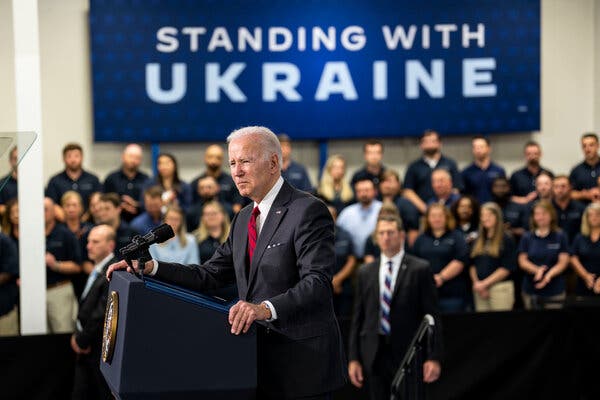
Last year, Lockheed could produce 7,500 of the artillery rockets that Ukrainian troops have fired to great effect from HIMARS launchers. This year, that number will jump to 10,000. But that is still far less than the Pentagon needs, even just to resupply Ukraine, and it is one of more than a dozen rocket and missile systems that contractors are now rushing to expand.
The surge in spending is likely to translate in the long run into increased profits at military contractors. But in the short term several of them, like Lockheed, continue to struggle to hire workers and eliminate shortages of key components needed to meet the Pentagon’s demand.
Lockheed expects its revenues to remain flat this year, even as the federal government pushes up spending.
Building up the additional needed capacity is likely to take several years.
“Any time you see an analysis that says, hey, we might not be prepared to achieve our strategic objectives, that’s concerning,” Frank A. St. John, the chief operating officer at Lockheed Martin, the nation’s largest military contractor, said in an interview. “We are on a path to address that need.”
Congress in December gave the Pentagon new power to award military contractors multiyear contracts to buy missile systems, providing financial commitments that allow them to hire more subcontractors or expand factories so they can build more missiles, knowing that there are profits to be made.
“It will give industry the real confirmation that they’re going to be in it for years to come,” Mr. LaPlante said. “That’s a big, big culture change.”
The Pentagon last year also created a team assigned to work with contractors to identify labor and supply chain shortages — and then gave out more than $2 billion in funding to quickly help resolve them.
That team started with a focus on resupplying weapons sent to Ukraine, Mr. LaPlante said, but it has now been set up as a more permanent unit inside the Pentagon to help the Defense Department make an “overall shift away from the just-in-time mind-set.”
In a reversal of post-Cold War policy, antitrust regulators have also increased scrutiny of continued military industry consolidation, with the Federal Trade Commission for example moving last year to block a $4.4 billion plan by Lockheed Martin to buy Aerojet Rocketdyne.
“We cannot afford to allow further concentration in markets critical to our national security and defense,” Holly Vedova, the director of the trade commission’s Bureau of Competition, said early last year, after the agency sued to block the deal.
Another major defense company, L3 Harris Technologies, which is the nation’s sixth largest, has moved to buy Aerojet, a deal that is still not completed. But contractors are also looking for new options to expand the ability to build rocket engines, with Lockheed asking for bids from a variety of potential new suppliers.
Aerojet has moved recently to expand its own rocket-engine plants in Arkansas and Alabama, where the company makes rocket motors for the SM-6 that the Navy is waiting for, as well as the PAC-3 missile, which Taiwan is waiting for as a defense against any incoming missile threats.
“D.O.D. leaders have signaled a critical need to replenish existing stockpiles,” the company said in a statement, “as well as a need to invest significantly to address overall munitions inventory.”
The Air Force has started to change the way it buys missile systems in part to expand the number of companies that manufacture key items like rocket engines, said Andrew Hunter, an assistant secretary at the Air Force in charge of acquisitions.
“It’s almost inconceivable that a single supplier is going to have the kind of capacity you’re going to need, if that conflict becomes extended,” he said after being asked about the rocket-engine shortage.
A shipment of defense equipment, including Javelin missiles, arriving at Kyiv’s Boryspil airport from the United States.Credit...Brendan Hoffman for The New York Times
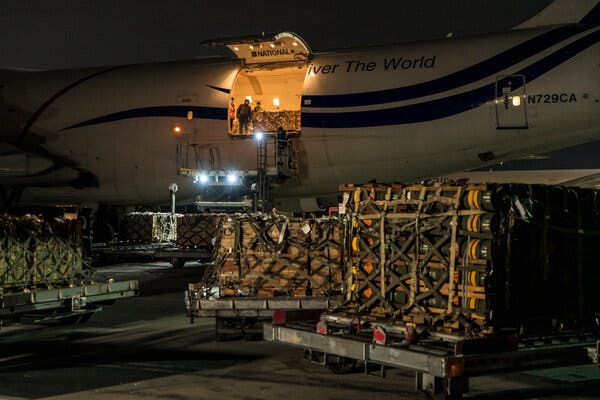
President Biden has also turned to the Defense Production Act — used during the pandemic to speed up the manufacturing of respirators and vaccines — to move ahead with new missile programs faster, including a number of hypersonic weapons being developed for the Air Force, the Army and the Navy.
All the moves have been needed because the United States underestimated the threats it now faces — or failed to prepare adequately, Pentagon officials acknowledged.
“No one anticipated the prolonged high-volume conflict we are seeing in Ukraine, or that we might see against a strategic competitor in the future,” Mr. LaPlante said this month, referring to China.
A surge in requests for weapons sales by the United States from allies in Europe and Asia will also help by creating more demand that can support domestic production lines.
For Taiwan alone, there is a $19 billion backlog of orders for American-made weapons — large chunks of it for Stinger missiles with rocket engines built by Aerojet that are already in short supply.
The Pentagon is also working with certain U.S. allies to create more partnerships, like a $1.2 billion contract awarded last year funding a joint project between Raytheon and the Norwegian defense firm Kongsberg to build a surface-to-air missile system called NASAMS that is being sent to Ukraine.
Ms. Hicks, the deputy defense secretary, said the goal is not necessarily to prepare to fight a war with China — it is to deter one from breaking out.
“Still, we must have the combat credibility to win if we must fight,” she said.
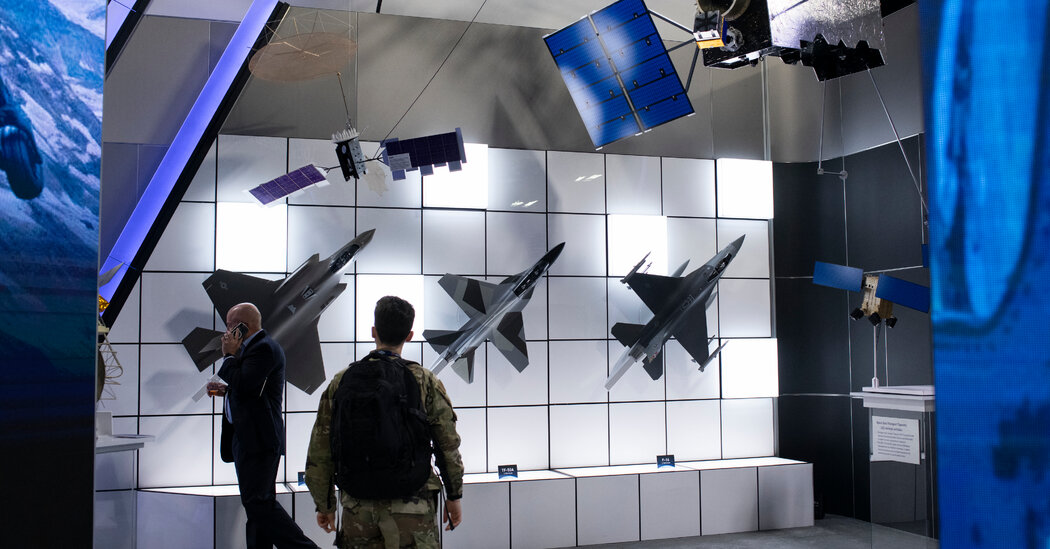
From Rockets to Ball Bearings, Pentagon Struggles to Feed War Machine
The flow of arms to Ukraine has exposed a worrisome lack of production capacity in the United States that has its roots in the end of the Cold War.


